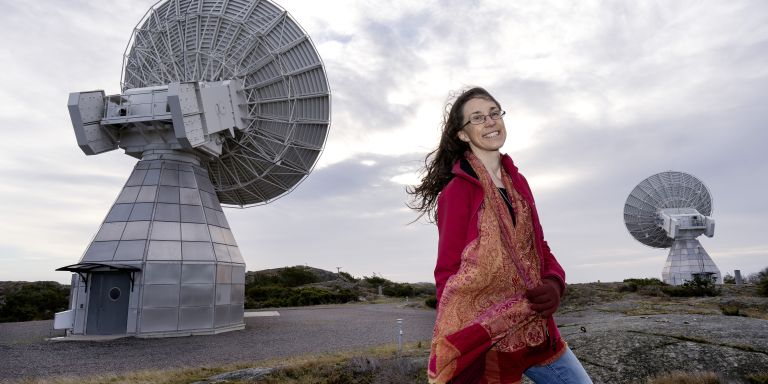
Kirsten Kraiberg Knudsen
Professor of Astronomy
Wallenberg Scholar
Institution:
Chalmers University of Technology
Research field:
Formation and evolution of galaxies


Wallenberg Scholar
Institution:
Chalmers University of Technology
Research field:
Formation and evolution of galaxies
When Knudsen was about ten years old, a rare event occurred that was to awaken her interest in space. Halley’s Comet passed by Earth in 1986. This happens only every 76 years.
“It was then I began to realize that space is much, much bigger than Earth and our own Solar system.”
Her curiosity about the mysteries of the Universe led to an academic career. She is now a professor of astronomy at Chalmers University of Technology in Gothenburg.
“Ultimately, astronomy is the quest for knowledge about our own origins. It’s rewarding to be able to find clues that help in solving the mystery.”
A central question is how galaxies are formed and evolve. Understanding galaxies in their present form entails a journey back in time to the birth of the Universe.
“A lot happened just after the Big Bang. If we can learn more about developments during the first one to three billion years, we’ll also gain an insight into why galaxies are the way they are now.”
“It means a great deal to receive the support of Knut and Alice Wallenberg Foundation. The grant gives me the freedom to explore relevant topics. I also have a unique opportunity to develop my leadership skills, establish a research environment and create an international network.”
Knudsen points out that research in astronomy has some similarities to archeology:
“We’re steadily extending the limits of how far back in time we can go. The most distant galaxy we have observed so far belongs to a point in time about 400 million light-years after the Big Bang. That’s about 13.3 to 13.4 billion years ago. Our branch of astronomy is sometimes likened to archeology.”
There are some two hundred billion galaxies in the Universe, maybe more. Our own galaxy is called the Milky Way, a giant made up of few hundreds of billions of stars. But there are also much smaller galaxies containing anything from tens of thousands of stars up to hundreds of billions of stars.
Scientists classify galaxies according to their shape. The Milky Way is a spiral galaxy containing large quantities of gas. When the gas is compressed, new stars form. Other galaxies are elliptical and include many old stars but almost no gas, which means no new stars are formed. A common feature of all large galaxies is also that they have huge black holes at their center.
Knudsen is studying quasars (quasi-stellar radio sources), which are extremely bright, active nuclei of galaxies with central black holes that grow very rapidly as they suck up huge quantities of matter from their surroundings.
“A crucial question is how the growth of a galaxy relates to the growth of these black holes. Do the processes occur simultaneously or does the black hole grow first, followed by the galaxy – or vice versa?”
The reality is complicated, and the researchers need to learn more about the various transitional phases. One phenomenon they are studying is the collision between two spiral galaxies. When the gas is compressed, a starburst results, with large numbers of stars forming in a short space of time.
“A mixture of cosmic dust, stars and gas is formed. This cloud of particles obscures the light and makes it hard for us to see what’s happening behind it. Much of the activity is concentrated in a small area, and the gigantic black hole grows.”
Once a quasar has formed, dramatic events in the galaxy peter out. No new stars are formed; existing ones continue to grow, and the galaxy eventually assumes an elliptical shape. This model describes galactic evolution, but linking the various phases together is a major challenge.
“One of the better-known galaxies – M87 – is a good example of the eventual form of a galaxy of this kind. Recently other astronomers obtained an excellent image of a black hole from M87.”
Several studies are based on data from the ALMA telescope, located at an altitude of five thousand meters in the Chilean desert. The facility was inaugurated in 2013, gathering radioastronomic data at millimeter wavelengths, enabling scientists to distinguish between old and new stars, and to study quasars.
“ALMA is an absolutely fantastic telescope that has yielded a wealth of unexpected results.”
The researchers strive to obtain signals that are as clear as possible, but resolution is one of the stumbling blocks.
“We’re used to seeing high-quality images from space, but the ones we’re analyzing mostly show patches of different light and colors.”
Knudsen points to a picture of an evolving galaxy. In a red area it is possible to discern a rotating disc, reminiscent of those seen in spiral galaxies.
“We don’t know whether it’s gas flowing outward or gas rotating. The inner part, yellowish-white in the picture, is a burgeoning quasar. But if we had time to wait about five to ten million years, the red part, which is the starburst, would have disappeared and things would look quite different. But life’s much too short of course.”
One solution is to make numerous observations at different time scales. Those data are integrated with theories, existing knowledge on galaxies and fundamental physical principles on light and energy to build general models.
“We are linking different processes together to obtain a bigger picture. We are constantly striving to be better at identifying type galaxies.”
Space continues to fascinate her. She points out that our knowledge is expanding rapidly:
“Until about a hundred years ago we believed the Universe was unchanging. It was then we began to realize that the Milky Way is merely one of several hundred billion galaxies. Now we can even start to see the first light and the first stages of the Universe. Although we cannot travel the kind of distances involved, we can still gain an idea of our origins.”
Text Nils Johan Tjärnlund
Translation Maxwell Arding
Photo Johan Wingborg